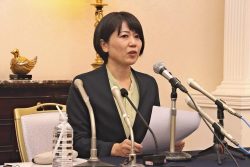Shizuoka Gubernatorial Race Could Decide Maglev’s Fate; 1 Candidate Opposes Construction, 2 Cautiously Favor It

Construction work on the tentatively named Kanagawa Prefecture Station is seen in Sagamihara on Friday.
17:23 JST, May 8, 2024
The fate of the planned Linear Chuo Shinkansen maglev line between Tokyo and Nagoya is set to be a major issue in campaigning for the Shizuoka gubernatorial election to be held May 26.
Shizuoka Gov. Heita Kawakatsu, who has resigned, has opposed construction of the 8.9-kilometer Shizuoka section of the maglev line in the name of protecting the flow of water in the Oi River.
Candidates in the race to replace him will be officially registered on Thursday. But whether debate on the issue will deepen remains to be seen.

People walk past a bulletin board explaining construction of the Linear Chuo Shinkansen maglev line at JR Shizuoka Station in Shizuoka City on Monday.
Opinion of residents
Three people plan to run in the election: former Shizuoka Deputy Gov. Shinichi Omura, 60; former Hamamatsu Mayor Yasutomo Suzuki, 66; and Daisuke Mori, 55; chairman of the prefectural committee of the Japanese Communist Party.
While Mori calls for the suspension of construction, Omura and Suzuki both call for balancing promotion of the maglev construction and environmental preservation.
During a public debate held on May 2, Omura emphasized, “I would responsibly solve it,” and “I would come up with results within one year.”
However, speaking to reporters after the debate, Omura seemingly backed off his stance, saying, “I only meant that I would pave ways to solving related issues [such as environmental concerns], and I didn’t mean that I would approve the start of the construction.”
Suzuki maintained a cautious posture throughout the debate. “I want to move the matter forward by bringing the central government, the prefecture, the municipalities of the [Oi River] basin and Central Japan Railway Co. [JR Tokai] to get together to solve each and every one of the related issues.”
One reason why Omura and Suzuki have been unable to come out strongly in favor of the construction is the fact that Kawakatsu won the last four gubernatorial elections overwhelmingly under the slogan of “protecting the water of the Oi River,” and it is not easy to read public opinion in the prefecture.
Regarding the Oi River, JR Tokai estimates that the construction of a new tunnel would cause groundwater to flow out of the mountains, reducing the river’s upstream flow by two tons per second below its current volume. In response to this estimate, Kawakatsu claimed that tap water and farming water for about 600,000 residents in the basin would be affected and demanded that the full volume of water that flows out should be returned to the river.
The JR side presented a plan to pump the water back up to the river and other measures to secure the river’s volume. This proposal was highly evaluated by an expert panel of the central government, but Kawakatsu still did not approve of the construction.
Drawing attention outside prefecture
Meanwhile, municipalities along the maglev line outside of Shizuoka Prefecture have displayed interest in what would happen after the election.
“I would like to see a person who will promote the linear line project be elected governor,” Sagamihara Mayor Kentaro Motomura bluntly stated at a press conference on April 23. In the city in Kanagawa Prefecture, the construction of the tentatively named Kanagawa Prefecture Station is underway.
In anticipation of the opening of the maglev line, the city last year adopted an urban development plan for areas around the new station and has also formulated a set of guidelines for the development.
Tsutomu Sanada, chairman of an association of local companies and residents who campaigned to have a station built in the city, said, “I want to see the person who will approve the Shizuoka section construction to be elected.”
“What needs to be cleared for the approval of the Shizuoka section?” asked Mayor Takeshi Sato of the city of Iida, Nagano Prefecture. “I want to see the new governor advance the matter in an easy-to-understand manner.”
In Iida, the tentatively named Nagano Prefecture Station is planned to be constructed, and the municipal government has compiled a plan to develop station-front plazas totaling 6.5 hectares of land to the north and south of the planned station. However, the city may have to review the schedules in the plan, as JR Tokai has given up its initial goal of opening the Tokyo-Nagoya route in 2027.
"Politics" POPULAR ARTICLE
-

Japan to Support Central Asian Logistics Route That Bypasses Russia, Plan to Be Part of Upcoming Summit in Tokyo
-

Japan to Tighten Screening of Foreigners’ Residential Status by Providing Information of Nonpayment of Taxes
-

Chinese, Russian Bombers Flew Unusual Path by Heading Toward Tokyo; Move Likely Meant to Intimidate Japan
-

Japan Plans National Database to Track Foreign Ownership of Real Estate, Land as It Weighs New Rules
-

Up to 199,000 Deaths Estimated From Mega-Tsunami; Most Recent Occurrence Took Place in 17th Century
JN ACCESS RANKING
-

Tokyo Economic Security Forum to Hold Inaugural Meeting Amid Tense Global Environment
-

Keidanren Chairman Yoshinobu Tsutsui Visits Kashiwazaki-Kariwa Nuclear Power Plant; Inspects New Emergency Safety System
-

Imports of Rare Earths from China Facing Delays, May Be Caused by Deterioration of Japan-China Relations
-

University of Tokyo Professor Discusses Japanese Economic Security in Interview Ahead of Forum
-

Japan Pulls out of Vietnam Nuclear Project, Complicating Hanoi’s Power Plans

























